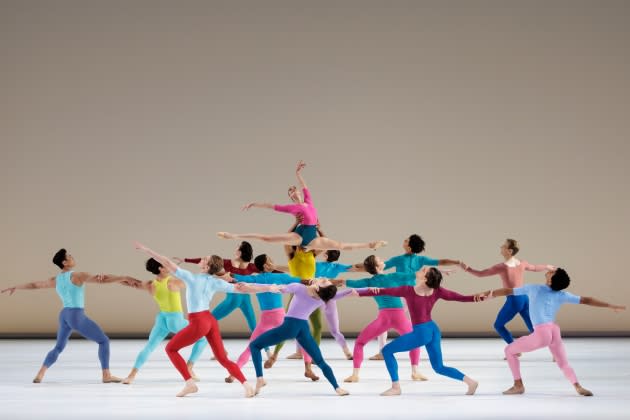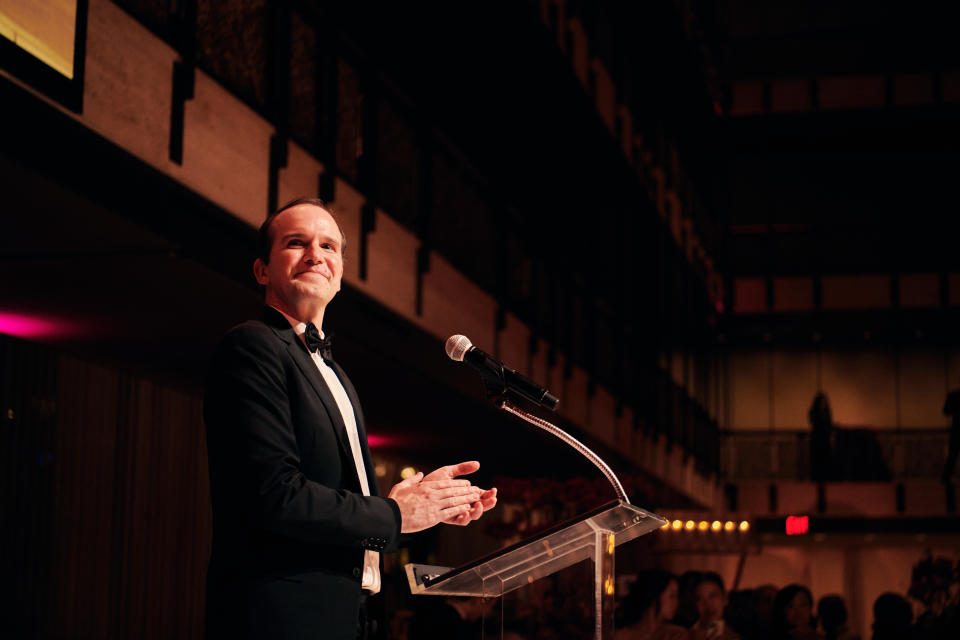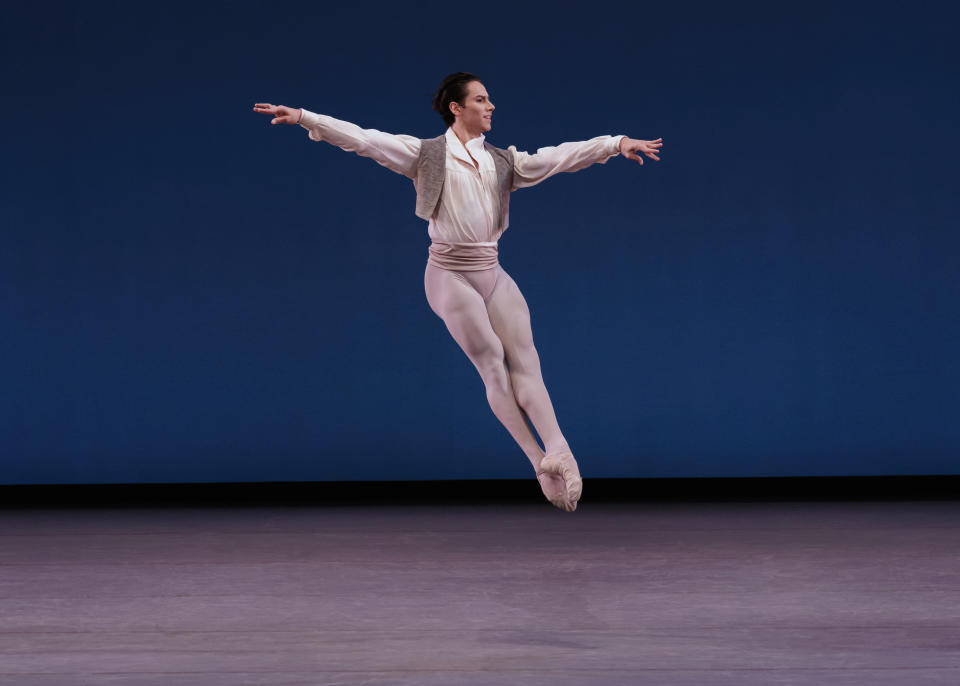EXCLUSIVE: New York City Ballet Artistic Director Jonathan Stafford on Modernizing the Company for a New Era

New York City Ballet is on the heels of announcing programming for its 75th anniversary year, and artistic director Jonathan Stafford says that his vision for the company is now coming into clear view.
In an exclusive interview with WWD at the School of American Ballet’s annual gala last month, Stafford said that the company’s youthful zest, its zeitgeist-driven collaborators and punchy costumes are driving the company forward and capturing a new generation of ballet-goers.
More from WWD
While he and associate artistic director Wendy Whelan — both former principal dancers with the company — officially took the helm four years ago, nearly a third of that time was spent with the theater closed and its company in isolation.
As City Ballet prepares to open its spring season on April 18, marking two years of performances since reopening the theater, its dancers — once only connected by a Zoom screen — are finally showing true cohesion.
“It’s my artistic vision, layered on top of the training, the coaching and new people we are bringing into the company. At this point I feel like I’m seeing the results of that vision come through at both the school and the company — the things I put into motion,” said Stafford, who also acts as SAB’s artistic director — meaning that he manages the company’s full pipeline of dancers, from their schooling up until their retirement.
“The Balanchine aesthetic is first and foremost in our training, so I’m just adding little touches and tweaks that my eye really responds to. It’s what I think this company needs in order to be vibrant and fresh and to be the New York City Ballet of the 21st century going forward,” he added.
A key word that Stafford seems to lean on is energy — in relation to the dancers, choreography, staging and the overall audience experience. In the fall, leading choreographer Alexei Ratmansky will join as the company’s artist-in-residence and bring that spirit into full-view.

The timing of that collective new energy is helping ballet thrive in a city when other art forms across the Lincoln Center Plaza — like opera and the philharmonic — are struggling to wrangle the same audience numbers they had prior to the pandemic.
City Ballet is often packed — even sold out — with younger audiences than ever, who cheer for its dancers and posts mementos from the evening to social media, bestowing the company with organic marketing after each performance, and driving its whole machine forward.
In September, City Ballet premiered Swarovski-drenched collaboration with Solange Knowles called “Play Time,” that returns to the stage this spring. Choreographed by Gianna Reisen, it isn’t the most visionary piece in City Ballet’s repertoire — but it represented a turning point for the company.
It ratcheted up engagement that hit a fever pitch in February with the company’s production of “Sleeping Beauty” — which appeared in many New Yorkers’ carousel of Instagram stories after each of its 14 performances.
Part of the excitement is owed to a changing of the guard among City Ballet’s roster of 93 dancers over the last two years. As tried-and-true dancers including Teresa Reichlen, Maria Kowroski and Sterling Hyltin have departed, a new generation has come up.
They include principals Unity Phelan, Indiana Woodward, Roman Mejia, Jovani Furlan, Chun Wai Chan and Mira Nadon — all of whom exude a new-day-type vibrancy — and upstarts like quick-witted soloist Emma Von Enck and apprentice Olivia Bell, whose gracious extension stands out from the back of the corps line.
Stafford said this is all part of his strategy to steward City Ballet into a new era. “Balanchine dancers have always been big movers — they fly across the stage. Sometimes that could be at the expense of clarity or technique. But if we drill down on the technique too much, you lose a little bit of the vibrancy and excitement. Well, I refuse to accept anything that’s not both,” he said.
“We have worked really hard at the school and the company to make sure there is intention in the work — not just how they take class, but how they take risks onstage with the right ideas in their head. I see this intentionality leading to better technique, but also bigger and bolder performance. There’s a confidence and energy that I don’t think we’ve seen in a while because of what we are doing at the school and supporting them when they get to the company. They’re not scared or afraid to go out there at their best.”

Nadon in particular, who was named principal in February, looks to be the company’s best run at a modern-day Suzanne Farrell — a tall, pliable dancer that exemplifies the Balanchine technique and whose sunny persona could make her a household name.
While ballet dancers have not been mainstream celebrities since the Baryshnikov era in the ’70s, ballet’s status as a viral cultural trend could position Nadon and others to join their ranks.
And that’s partly thanks to balletcore — a social media trend in which dancers take followers through their day in idealized video diaries awash in blush pink and healthy smoothie bowls. Company dancers, including newly appointed soloist Olivia MacKinnon and corps member Jenelle Manzi, are among them.
The trend has now spilled over into fashion, with indie brands like Sandy Liang and Medea releasing pointe shoes and warm-up booties that are made to be worn by nondancers on the street.
When asked about balletcore, Stafford said that he had not heard of it. He was happy though — it helps him ensure there is a certain hype and mystique surrounding the company to draw new audiences in.
But once they arrive at the theater, Stafford also has to deliver a level of performance that warrants follow-up visits.
“Our focus is making sure the ballets are really alive — whether it’s a ballet made in the ’30s like ‘Serenade,’ or one created this year. What we’re finding with these younger audiences is that they respond to something that they can connect to — whether it’s the diversity they’re seeing on the stage or the diversity of the stories we’re telling.
“If something looks a little flat or too polished and safe, they are not going to make the effort to come in. We want things to be on the edge — pushing boundaries with how much energy they’re bringing to the execution. We are giving them a little more rehearsal time so they’re more prepared and can go onstage and let go. We’re trying to make each night special, so someone says, ‘I’m going to go see that because I can’t miss it.’”
Enough time has now passed since Stafford and Whelan took the helm following longtime director Peter Martins’ abrupt departure, that some of City Ballet’s youngest dancers have only come up in a culture shaped by the company’s new administration.
Martins left upon allegations of sexual misconduct, but an internal investigation did not support evidence of those claims, the company said publicly. Shortly after, the company was rocked by a widely publicized texting scandal that led to the departure of top male talent. In the time since, City Ballet has been working to clear its reputation by focusing on internal culture.
Stafford feels that transparency between the company’s administrative staff and its dancers has improved.
“There’s a couple committees of dancers that meet with artistic leadership and give us feedback and ask us questions. They take that back to the dancers. So we’re seeing a lot less misconception about how decisions are made. Not everyone is going to agree with the decision, which is true at any organization and that’s fine, but at least they understand what went into it,” he said.
Since stepping into the company’s lead role, Stafford has placed diversity at the cornerstone of the company’s future-making plans. While the company’s roster is beginning to reflect those efforts, City Ballet has not had a Black female principal or soloist in its history. Bell, along with a group of other strong dancers, may eventually change that.
Nadon, who is the company’s first Asian-American female principal, was fast-tracked to the top rank after joining the company in 2018. Stafford said this is part of his plans to improve NYCB’s culture: “Mira is amazing. If we hadn’t missed a year-and-a-half with COVID[-19], she would have been a principal dancer already. That kind of energy is contagious — that kind of young energy, with no fear and just confidence will push our other young dancers.”
Best of WWD

